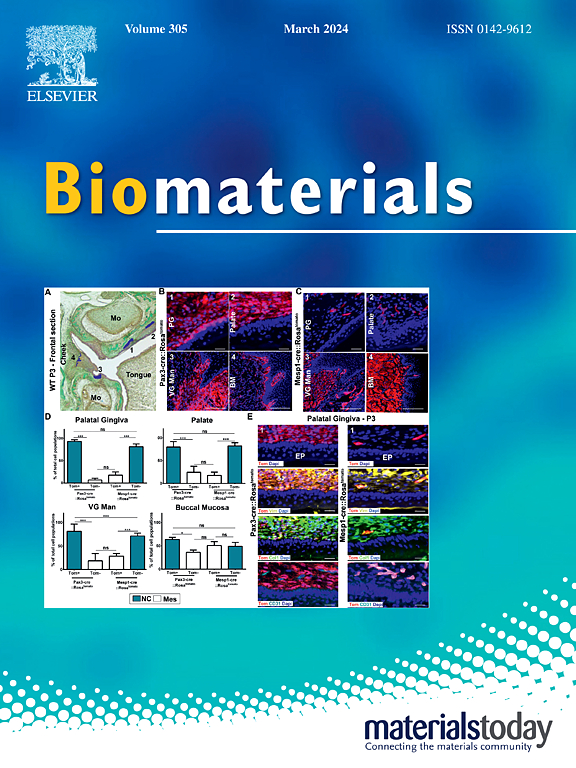Genetically engineering cells to produce therapeutically boosted extracellular vesicles for cardiovascular calcification
IF 12.8
1区 医学
Q1 ENGINEERING, BIOMEDICAL
引用次数: 0
Abstract
Calcification associated with atherosclerosis is a major driver of morbidity globally. Despite the correlation of calcification with plaque rupture and sudden death, there are no clinically approved therapies that treat vascular calcification. Notably, vascular smooth muscle cells (VSMCs) represent a promising target to inhibit vascular calcification, as VSMCs are the primary source of calcification deposition in the vasculature. To that end, we report a novel approach using extracellular vesicles (EVs) to deliver anti-osteogenic miR-133 to osteochondrogenic VSMCs in atherosclerosis. Traditionally, loading miRs into EVs is marred by low loading efficiency, inefficient EV modification, miR degradation, or loss of EV structural integrity. To address these challenges, VSMCs were transduced to create cell lines expressing miR-133 modified with ExoMotifs, or 4–8 nucleotide motifs which enable binding to proteins involved in miR sorting, resulting in VSMCs that secrete EVs highly loaded with miR-133. Additionally, EVs were surface functionalized with a hydroxyapatite binding peptide (HABP) to enable targeting to areas of vascular calcification. Our results show that HABP-miR-133-EVs can inhibit osteochondrogenic VSMCs, promote contractile VSMCs genes, and inhibit vascular calcification both in vitro and in vivo in murine atherosclerosis models. More broadly, we demonstrate a platform strategy to develop cellular factories for miR-loaded, therapeutic EVs that can be tailored for a variety of diseases.
基因工程细胞产生治疗促进细胞外囊泡心血管钙化
与动脉粥样硬化相关的钙化是全球发病率的主要驱动因素。尽管钙化与斑块破裂和猝死相关,但目前尚无临床批准的治疗血管钙化的方法。值得注意的是,血管平滑肌细胞(VSMCs)是抑制血管钙化的一个有希望的靶点,因为VSMCs是血管中钙化沉积的主要来源。为此,我们报告了一种使用细胞外囊泡(EVs)将抗成骨miR-133递送到动脉粥样硬化中成骨软骨细胞的新方法。传统上,将miR加载到电动汽车中会受到加载效率低、电动汽车改性效率低、miR降解或电动汽车结构完整性丧失的影响。为了解决这些挑战,VSMCs被转导成表达经ExoMotifs修饰的miR-133的细胞系,或4-8核苷酸基序,可与miR分选相关的蛋白质结合,从而使VSMCs分泌高负载miR-133的ev。此外,利用羟基磷灰石结合肽(HABP)对ev进行表面功能化,使其能够靶向血管钙化区域。我们的研究结果表明,在小鼠动脉粥样硬化模型中,HABP-miR-133-EVs可以抑制成骨软骨细胞VSMCs,促进VSMCs基因收缩,并抑制血管钙化。更广泛地说,我们展示了一种平台策略,用于开发装载mir的细胞工厂,治疗性ev可以针对各种疾病进行定制。
本文章由计算机程序翻译,如有差异,请以英文原文为准。
求助全文
约1分钟内获得全文
求助全文
来源期刊

Biomaterials
工程技术-材料科学:生物材料
CiteScore
26.00
自引率
2.90%
发文量
565
审稿时长
46 days
期刊介绍:
Biomaterials is an international journal covering the science and clinical application of biomaterials. A biomaterial is now defined as a substance that has been engineered to take a form which, alone or as part of a complex system, is used to direct, by control of interactions with components of living systems, the course of any therapeutic or diagnostic procedure. It is the aim of the journal to provide a peer-reviewed forum for the publication of original papers and authoritative review and opinion papers dealing with the most important issues facing the use of biomaterials in clinical practice. The scope of the journal covers the wide range of physical, biological and chemical sciences that underpin the design of biomaterials and the clinical disciplines in which they are used. These sciences include polymer synthesis and characterization, drug and gene vector design, the biology of the host response, immunology and toxicology and self assembly at the nanoscale. Clinical applications include the therapies of medical technology and regenerative medicine in all clinical disciplines, and diagnostic systems that reply on innovative contrast and sensing agents. The journal is relevant to areas such as cancer diagnosis and therapy, implantable devices, drug delivery systems, gene vectors, bionanotechnology and tissue engineering.
 求助内容:
求助内容: 应助结果提醒方式:
应助结果提醒方式:


